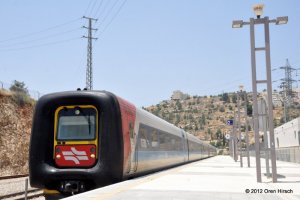 IC3 DMU 7203
IC3 DMU 7203
Location: Jerusalem-Malha Station, Jerusalem, Israel
Operator of Vehicle: Israel Railways
Date of Photo: May 18, 2012
Israel Railways, the only operator of the IC3 DMU trainsets outside of Scandinavia, retired the rolling stock type in the past month. The IC3 was introduced to Israel in 1992. At the time, it was the first new rolling stock purchased by Israel Railways in over 20 years and the trains quickly became popular with staff and passengers alike due to their spacious interior layout and other modern (for the time) features.
The most notable feature on the exterior of these trains is the rubber diaphragm at the end of each three car set. When two sets were coupled together, the entire cab would be folded back allowing for seamless movement between the individual trainsets. This setup also meant that a train could be easily split or recoupled almost “on the fly” so to speak, for example, to separate to provide service to a branch line. Each trainset consisted of three cars and up to five trainsets could be coupled together to create a 15 car train.
In 1997, two Israel Railways trainsets were demoed by Amtrak in the United States and VIA Rail in Canada. Called the “Flexliner” for North American marketing purposes, Amtrak trialed the train on the Hiawatha, Kansas City Mule, St. Louis Mule, San Diegan, and Cascades services, while VIA used it in the Windsor-Quebec corridor. The trains were certainly a novelty and garnered some attention during their time in North America, but neither operator purchased them.
In Israel, the IC3 was the only rolling stock to operate on the old Jerusalem-Tel Aviv route, as this was the only equipment that had the power to go up the steep grades on this line (any other train would have had to be “doubleheaded” due to the gradients). They were also mainstays on the Be’er Sheva-Dimona line and, since its 2019 opening, the Jezreel Valley line to Beit She’an. However, their age combined with the closure of the old Jerusalem-Tel Aviv route during the Covid-19 pandemic means that Israel Railways can replace them with newer equipment, especially as the project to electrify the entire network proceeds.
I rode them a number of times on the old Jerusalem-Tel Aviv line. They certainly are unique trains and while the new high speed line between Jerusalem and Tel Aviv is a game changer for getting between the two cities, the retirement of the IC3 will make the Israel Railways fleet more homogenous and less diverse.
Did you ever ride the IC3 in Israel? What about Denmark, Sweden, or on its North American tour in 1997? Post a comment either way! You can still find the IC3 in revenue service in Scandinavia, and one Israel Railways set has already been preserved at the Israel Railways Museum in Haifa.
For more photos of Israel Railways’ IC3 “Flexliner” DMUs, please click here. And to learn more about these trains, you can read this article from Walla News (Hebrew only).
